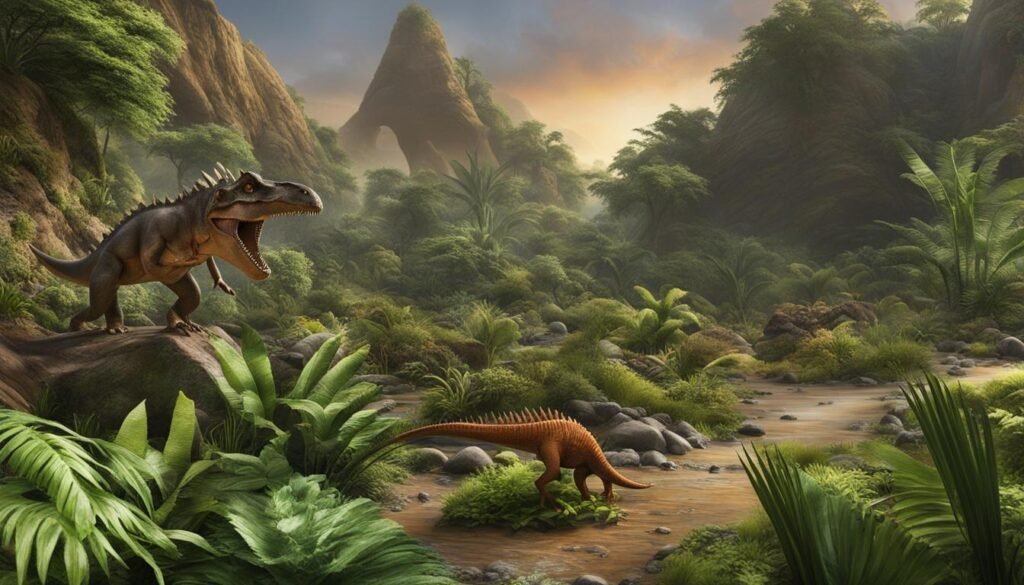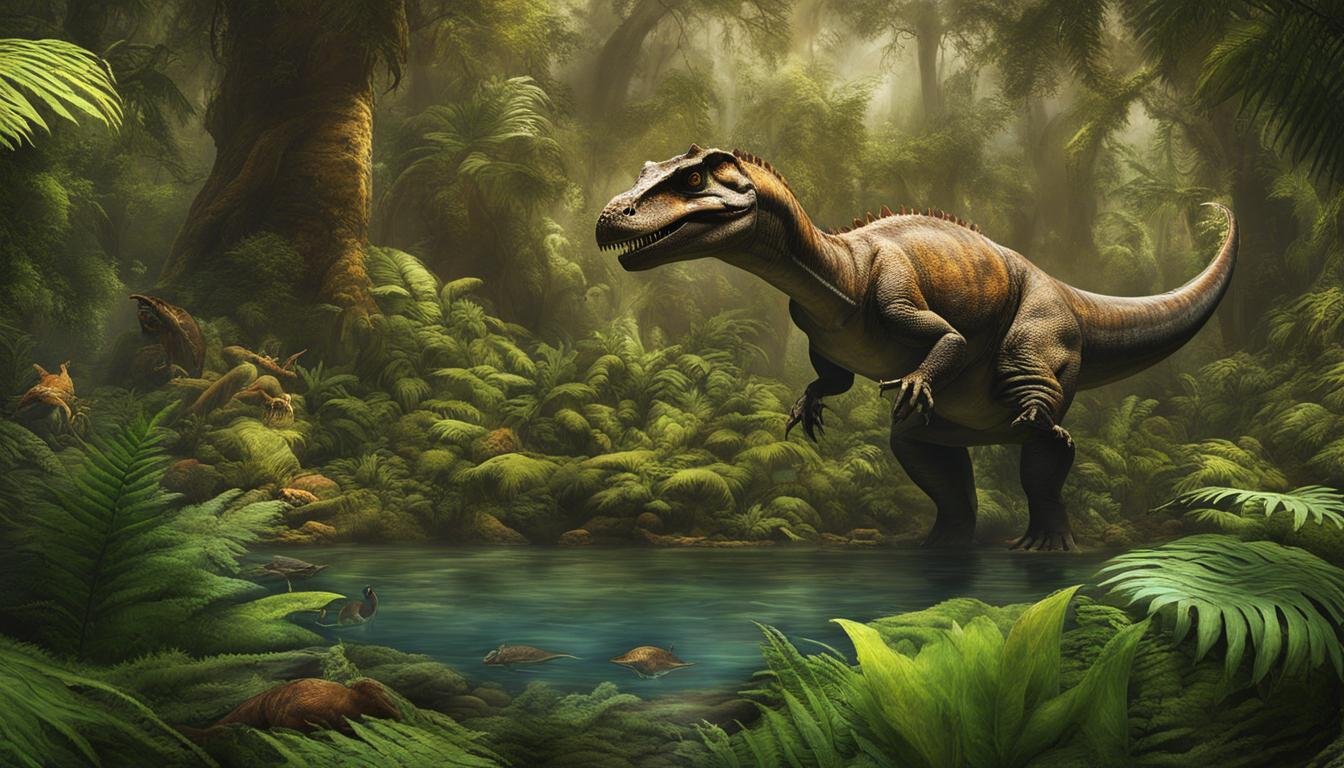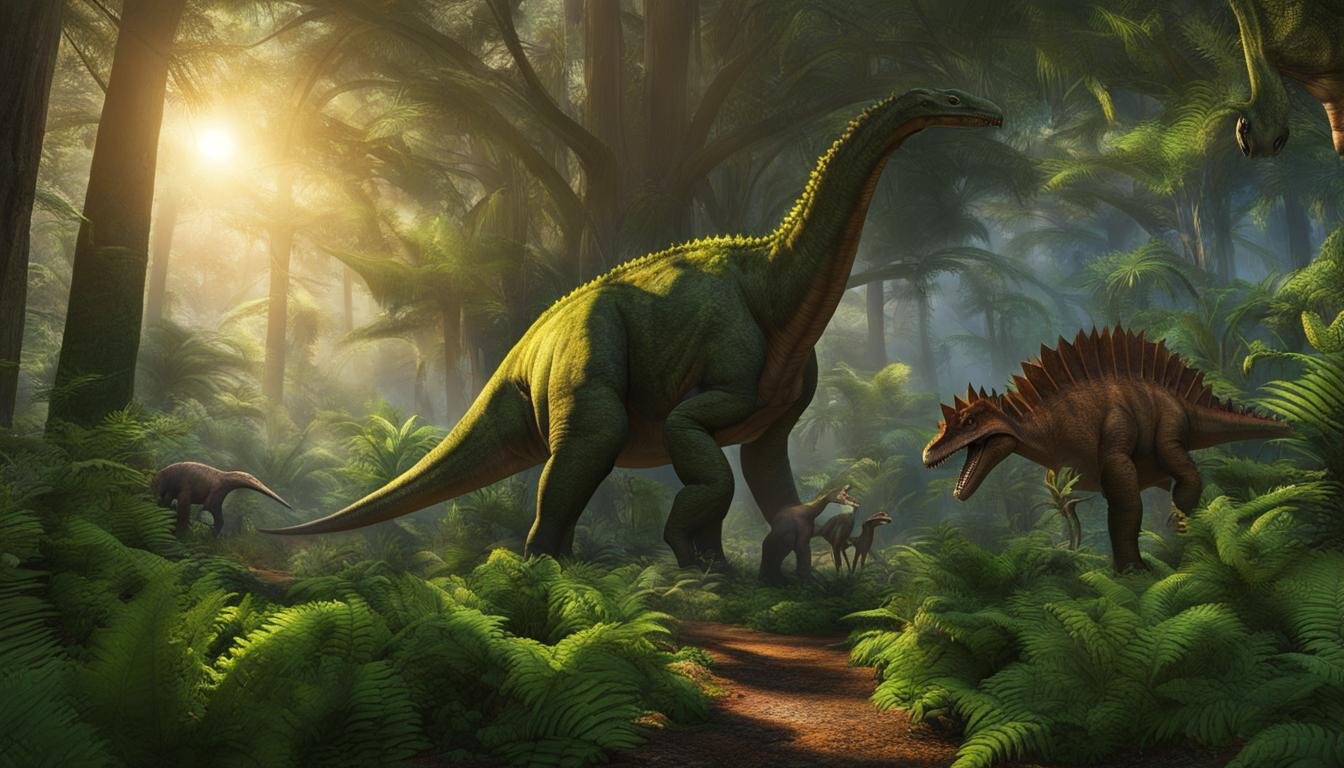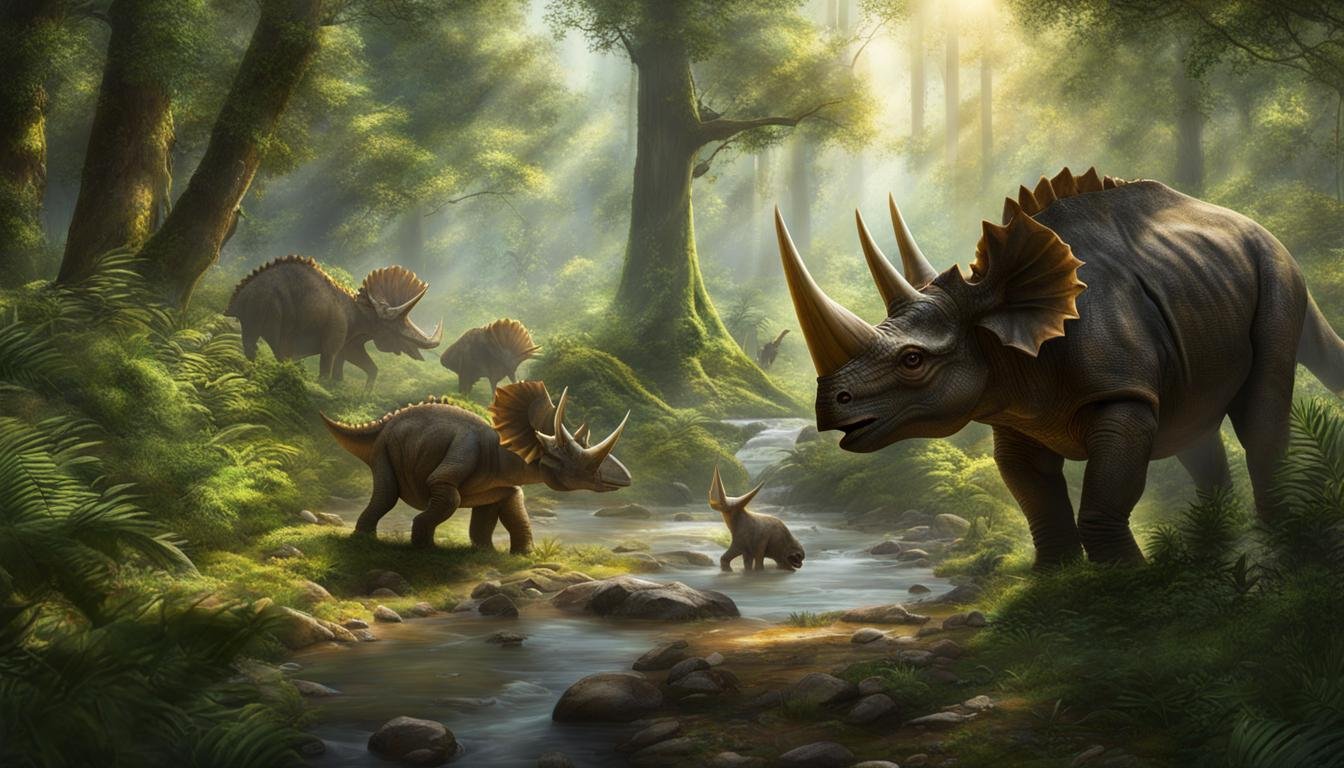Welcome to our exploration of the fascinating relationship between plants and dinosaurs in prehistoric ecosystems. The Late Cretaceous period, approximately 70 million years ago, was a pivotal time for both ancient forests and dinosaur biodiversity. In this article, we will delve into the Cantwell Formation rocks in Denali, Alaska, which provide a unique window into the plant life that sustained dinosaurs during this period.
Researchers have been studying the plant fossils found in Denali to unravel the mysteries of the Late Cretaceous. These plant remains offer valuable insights into the paleoclimate and paleoecosystems of the time, and shed light on the crucial role of plants in supporting dinosaur life. By examining the plant fossils, we can better understand the impact of environmental changes on ancient ecosystems and gain a deeper appreciation for the interconnectedness of all living organisms.
| Main Point | Description |
|---|---|
| Importance of Plants in Dinosaur Era | Plants were a vital component in supporting dinosaur life during the Late Cretaceous period. |
| Insights from Cantwell Formation | The Cantwell Formation in Denali, Alaska, offers significant information about plants, animals, and the environment during that time. |
| Plant Fossils and Paleo Studies | Examining plant fossils is key to understanding the paleoclimate, paleoecosystems, and the concurrent evolution of plants and dinosaurs. |
| Dinosaurs’ Influence on Plant Evolution | Dinosaurs affected plant evolution through their feeding behaviors and by aiding in seed dispersal. |
| Relevance of Plant-Animal Interactions | Studying plant-animal interactions in ancient ecosystems can provide insights relevant to modern conservation and ecological management efforts. |
Denali’s Paleobotanical Discoveries
The sedimentary layers in Denali’s Cantwell Formation contain a rich fossil record of plants from the Late Cretaceous. Over 12 different leaf types, along with woody and herbaceous plant stems and cones, have been documented in these rocks. These plant communities thrived in the Cantwell Basin, near freshwater ponds and streams.
The presence of these plant fossils allows scientists to reconstruct ancient ecosystems and understand the vegetation zones in which the dinosaur inhabitants of the Cantwell Basin lived. The plant fossils also provide valuable information about the coevolution of plants and dinosaurs during this time.
By studying these paleobotanical discoveries, researchers gain insights into the types of plants that were present in the Late Cretaceous and the ecological relationships between plants and dinosaurs. The fossil record helps paint a picture of the diverse plant life that sustained the dinosaurs of Denali millions of years ago.
Dinosaurs and the Evolution of Plants
While dinosaurs are often associated with their iconic role as towering predators or thundering herbivores, their impact on the natural world extends beyond their size and strength. In fact, dinosaurs played a significant role in the evolution of plants, shaping the flora of their ancient ecosystems and influencing the development of plant species.
Large herbivorous dinosaurs, such as stegosaurs and sauropods, had a profound effect on plant evolution through their feeding habits. These dinosaurs consumed plants like cycads and conifers, which led to selective pressures on vegetation. As a result, fast-growing plants with adaptations for withstanding heavy browsing, such as angiosperms or flowering plants, were favored. This contributed to the proliferation of flowering plants during the Late Cretaceous period.
Not only did dinosaurs influence the evolution of plants through their diet, but they also played a role in seed dispersal. Some dinosaurs unknowingly spread plant species by ingesting seeds along with their food and depositing them in different locations. This process allowed for the dispersal and colonization of new plant species, contributing to the diversity of plant communities.
Dinosaur Diet and Plant Evolution
To understand the impact of dinosaurs on plant evolution, scientists study fossilized dinosaur dung, also known as coprolites. By examining the contents of coprolites, researchers can identify the plant matter that was consumed by different dinosaur species. This data helps reconstruct the diets of dinosaurs and the plant species they interacted with, providing valuable insights into plant-animal interactions and coevolution.
| Dinosaur | Diet | Plant Interactions |
|---|---|---|
| Stegosaurus | Herbivorous | Consumed cycads and conifers, influencing the evolution of woody plants |
| Brachiosaurus | Herbivorous | Consumed high-growing vegetation, contributed to the evolution of tall trees |
| Triceratops | Herbivorous | Consumed low-lying vegetation, influenced the growth of ground cover plants |
The coevolution of dinosaurs and plants during the Late Cretaceous period shaped the landscape and biodiversity of ancient ecosystems. As plants evolved to adapt to the browsing habits of dinosaurs, new ecological niches were created, allowing for the diversification of both plants and dinosaurs. Understanding these plant-animal interactions provides valuable insights into the intricate balance of prehistoric ecosystems and the factors that contributed to their resilience and growth.

“The interaction between dinosaurs and plants highlights the intricate web of life that existed during the Late Cretaceous. It is a testament to the interconnectedness of all organisms in an ecosystem and the profound impact that even the largest creatures can have on their environment.” – Dr. Jane Paleontologist
By studying the coevolution of dinosaurs and plants, researchers gain a deeper understanding of the challenges and adaptations that shaped ancient ecosystems. This knowledge can provide valuable insights for modern conservation efforts and offer lessons on how to preserve and restore ecosystems in the face of environmental changes. The study of dinosaur diet, plant-animal interactions, and plant evolution continues to unlock fascinating discoveries about the natural world and the remarkable interplay between its inhabitants.
Megaherbivores and the Evolution of Plant Defense
The absence of large herbivores during the 25-million-year “megaherbivore gap” had a significant impact on plant evolution. Research on fossil and living palms has revealed intriguing insights into how plants adapted to this period of reduced herbivory pressure. One notable finding is that the evolutionary speed of new palm species with small fruits decreased, while those with large fruits remained constant.
These findings suggest that the absence of large herbivores led to denser vegetation, creating an opportunity for plants with larger seeds and fruits to thrive. With fewer herbivores present, plants could invest more resources in producing larger fruits, as there was less pressure for small fruits to be dispersed over long distances. This adaptation allowed certain palm species to persist and maintain steady evolutionary rates during the megaherbivore gap.
Furthermore, the defense traits of plants, such as spines and thorns, also underwent changes during this period. Studies have shown that these defense traits decreased in the absence of large herbivores but reappeared when new megaherbivores evolved. This indicates that the presence of megaherbivores exerted selective pressure on plants, leading to the reemergence of defense mechanisms as a way to deter herbivory.
Dinosaur Habitat and Sediment Deposition in Denali’s Geology
Denali’s unique geological history provides a window into the ancient world of dinosaurs. The sedimentary layers of the Cantwell Formation in Denali, Alaska hold valuable clues about the habitat and environmental conditions in which these prehistoric creatures thrived. The rocks of the Cantwell Formation were formed through the deposition of sediments shed from the rising mountains of Alaska’s geologically active region. These sediments, including sands, gravels, and muds, were transported to the lowlands via rivers and wind, eventually forming the Cantwell Basin.

Studying these sediments allows scientists to reconstruct the ancient ecosystem supported by lakes and streams in Denali. By analyzing the sedimentary layers and the types of sediments deposited, researchers can gain insights into the nature of the ancient landscape and the conditions that shaped it. This knowledge is crucial for understanding the distribution of resources, such as water and vegetation, that were essential for supporting dinosaur life in Denali during the Late Cretaceous period.
The sedimentary record in Denali also provides valuable information about the changing environmental conditions that occurred over millions of years. By studying the composition and characteristics of the sediments, scientists can uncover evidence of past climate fluctuations and geological events. This information aids in our understanding of how these factors may have influenced the evolution and adaptation of both plants and dinosaurs in Denali’s ecosystem.
| Sediment Type | Composition |
|---|---|
| Sands | Coarse-grained particles consisting of minerals, rocks, and fossil fragments. |
| Gravels | Rounded or angular fragments of various sizes, often composed of pebbles, cobbles, or boulders. |
| Muds | Fine-grained particles, such as clay or silt, which settle in calm water and form layers of sediment. |
This table illustrates the different sediment types found in the Cantwell Formation and provides a glimpse into the geological processes that shaped the ancient landscape of Denali. By analyzing these sediments, scientists can reconstruct the environmental conditions and the specific habitats in which dinosaurs lived, contributing to a deeper understanding of the interactions between dinosaurs and their prehistoric surroundings.
Studying Cretaceous Ecosystems in Denali
Dr. David Sunderlin and a team of scientists from Lafayette College and the National Park Service are conducting paleontological research in Denali, Central Alaska, to study the full ecosystem preserved in the Cantwell Formation. This collaborative project aims to reconstruct and understand the complex interplay of plant, vertebrate, invertebrate, and environmental records of the Late Cretaceous period. By examining the plant fossils found in Denali, the team can reconstruct ancient ecosystems and gain insights into the dynamics of prehistoric life.
The research conducted in Denali provides a unique opportunity to study a high-latitude Late Cretaceous ecosystem in detail. The Cantwell Formation in Denali preserves a diverse range of fossils that offer valuable clues about the ancient plants and animals that once thrived in this region. Through careful analysis of these fossils, the scientists can reconstruct the vegetation zones, identify plant-animal interactions, and reveal the impact of environmental changes on the ecosystem.
“The plant fossils found in Denali provide a window into the past, allowing us to reconstruct the ecological relationships and dynamics of a long-lost world,” explains Dr. Sunderlin. “By studying these ancient ecosystems, we can gain insights into the origins and inner workings of present-day high-latitude ecosystems and better understand how they may be affected by extinction and climate change.”
In addition to the plant fossils, the sediments preserved in Denali’s Cantwell Formation also provide crucial information about the habitat and environmental conditions of the dinosaurs that once roamed in this area. The study of sediment deposition and terrane collision helps scientists reconstruct the ancient landscape and understand the geological processes that shaped the region. This interdisciplinary approach allows for a comprehensive understanding of the ancient ecosystem and its evolution over time.
Through their paleontological research in Denali, Dr. Sunderlin and his team are contributing to the broader field of ecosystem reconstruction and our understanding of prehistoric life. Their findings provide valuable insights into the intricate web of interactions between plants, animals, and the environment, shedding light on the complexity and resilience of ancient ecosystems. This knowledge has implications for the conservation and management of present-day ecosystems, as we strive to protect and preserve biodiversity in the face of ongoing environmental changes.
Paleontological Research in Denali: Key Insights
- The collaboration between Lafayette College and the National Park Service allows for a comprehensive study of the Late Cretaceous ecosystem preserved in Denali’s Cantwell Formation.
- The plant fossils found in Denali provide valuable information about ancient vegetation zones, plant-animal interactions, and the impact of environmental change on ecosystems.
- Studying sediments and terrane collision in Denali helps reconstruct the habitat and environmental conditions of the dinosaurs that once lived in the area.
- The research in Denali contributes to our understanding of high-latitude ecosystems, their origins, and the effects of extinction and climate change.
- By gaining insights into prehistoric ecosystems, we can better manage and conserve present-day ecosystems.
The Importance of Paleobotanical Research
Paleobotanical research plays a crucial role in our understanding of Earth’s ancient history, providing valuable insights into paleoclimate and paleoecosystems. By studying plant fossils, scientists can reconstruct past vegetation zones and gain a better understanding of the environmental conditions and changes that occurred during the Late Cretaceous period. This knowledge allows us to piece together the intricate dynamics of prehistoric ecosystems and the significant role that plants played in supporting diverse life forms, including dinosaurs.
One of the key contributions of paleobotany is its ability to shed light on paleoclimate. By examining plant fossils, researchers can analyze various factors such as leaf shape, stomatal density, and growth patterns, providing valuable information about temperature, precipitation, and atmospheric composition in the past. This data helps us understand the Earth’s climate history and provides insights into how present-day ecosystems may be affected by ongoing climate change.
“Paleobotanical research enables us to reconstruct past ecosystems and study the complex interactions between plants and animals in ancient times.”
Paleobotanical research also allows us to study plant-animal interactions in prehistoric ecosystems. By analyzing fossilized pollen, seeds, and gut contents found in dinosaur fossils, scientists can gain insights into the diets of these ancient creatures and their feeding preferences. This information, coupled with the study of plant adaptations for defense and seed dispersal mechanisms, provides a comprehensive understanding of the coevolutionary relationships between plants and dinosaurs.
The Role of Paleobotany in Conservation and Management
The knowledge gained from paleobotanical research has significant implications for conservation and ecological management in the modern world. Understanding how past ecosystems responded to environmental changes can help us predict and mitigate the impacts of ongoing climate change on present-day ecosystems. By studying the adaptations of plants to changing conditions, we can identify resilient species and design strategies for ecosystem restoration and preservation.
Additionally, paleobotanical research provides insights into the potential effects of the extinction of key plant and animal species. By studying the fossil record, scientists can identify patterns of biodiversity loss and the subsequent impacts on ecosystem functioning. This information is crucial for developing effective conservation strategies and understanding the potential consequences of species loss in current and future ecosystems.
| Benefits of Paleobotanical Research | Implications for Conservation and Management |
|---|---|
| Reconstructs past vegetation zones | Helps predict and mitigate impacts of climate change |
| Provides insights into paleoclimate | Identifies resilient plant species for ecosystem restoration |
| Studies plant-animal interactions | Understands consequences of species loss in ecosystems |
| Improves understanding of coevolutionary relationships | Informs conservation strategies |
Overall, paleobotanical research is a powerful tool for unraveling the mysteries of Earth’s past and informing our stewardship of ecosystems today. By studying the fossils of ancient plants, we gain insights into the intricate web of life that existed millions of years ago, and in turn, can apply this knowledge to ensure the preservation and sustainability of our present and future environments.
Conclusion
In conclusion, the role of plants in dinosaur ecosystems was vital for the survival and diversity of these magnificent creatures. The plant fossils found in Denali and other locations provide valuable insights into prehistoric ecosystems and the intricate dynamics of plant-animal interactions. By studying these ancient records, scientists can reconstruct past vegetation zones, understand the coevolution of plants and dinosaurs, and gain a deeper understanding of the impact of environmental change on ecosystems.
Plants served as a crucial food source for many dinosaur species, influencing their diets and playing a significant role in their evolution. Likewise, dinosaurs played a part in seed dispersal, contributing to the spread of plant species. This interdependence between plants and dinosaurs shaped the landscape of the Late Cretaceous period and highlights the delicate balance that exists in ecosystems.
By delving into Earth’s ancient history, we can glean important lessons for the conservation and management of present-day ecosystems. Understanding the intricate relationships between plants and animals is essential for the preservation of biodiversity and for ensuring the long-term health of our planet. The study of plant-animal interactions in dinosaur ecosystems not only enriches our knowledge of the past but also guides our efforts in dinosaur conservation and the protection of our natural world.









